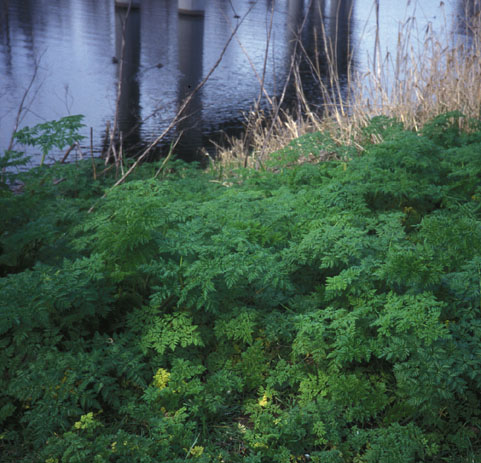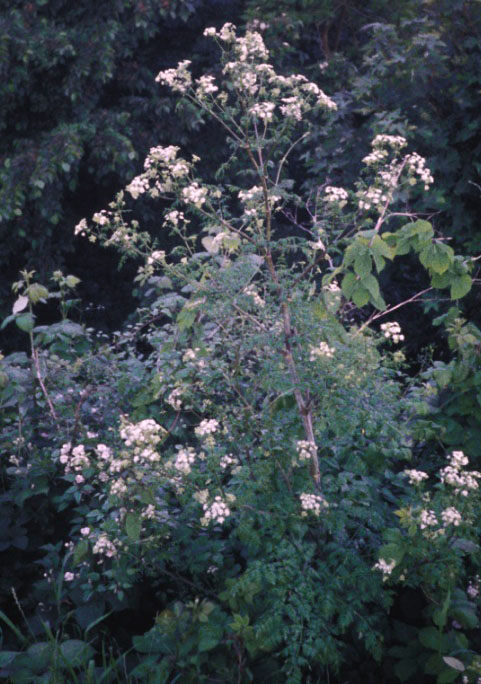
|

|

|
| Poison Hemlock; Conium maculatum L. |
Carrot Family; UMBELLIFERÆ (APIACEÆ)
|
| There are two major kinds of hemlock you should know. Washington's official state tree is one, an abundant native evergreen
that keeps company with firs and cedars. The other, our present subject, is a big smelly weed naturalized from Europe. Both the conifer
and the herb are beautiful and excel in Seattle's climate. |
| If it was not called Poison Hemlock, the plant might be known as Stinking Hemlock; by offensive smell alone it can be told. Its
heavy, almost sedative scent hangs thick in the air, especially at flowering time (May through July primarily). Other names are Poison
Stinkweed, Deadly Hemlock, Poison Parsley, Snakeweed, and Wode Whistle. |
| You need not go far to find some: Poison Hemlock grows with booming vigor in many waste areas, reaching its largest size in
rich soil, a bit shaded. |
| Seeds can sprout in fall, grow through the winter, then send up flowerstems the next summer. The seedling stage is
somewhat reminiscent of non-crisped parsley, or of carrot greens, but still more lush. The flowerstalk grows as high as 12 feet, is hollow,
perfectly smooth to the touch, and is supported by a parsnip-like taproot that can be more than
31/2 feet deep. Overall, the plant exhibits a
delicacy bordering on fragility: the ferny, finely dissected leaves, slender stems, and ever so tiny white flowers, all suggest the most refined,
gentle beauty. If, however, you approach the plant closely, its sturdy green stem marked with purplish blotches, as well as its stifling smell,
sully its otherwise angelic atmosphere. |
| The flowers are choice attractants to various insects, which is also true of those borne by various of the herb's kindred. For
cousins of this fatal plant include some of our most dearly prized delicacies: fennel, carrot, coriander, angelica, chervil, parsley, parsnips,
and caraway. |
| There is a tradition, not certain but probable, that it was with a tea of
Conium maculatum that Socrates launched his immortality
in Athens. "Athenians," he said at his trial, "I love and honor you . . . but I will obey God rather than you." Other deadly herbs in the
same plant family might also have done the job. Conium kills by making the body relax and stop working, so breathing, too, ceases. |
| Some books relate how people have died horribly from mistaking Poison Hemlock for an edible plant. It has also been averred
that the deadly properties of the plant are so highly volatile as to be destroyed by cooking. Don't try it. If the roots were found to be less
toxic, and cooking did render them harmless, then a great amount of food would be available potentially. |
| A scary plant, of fetid odor, we should be cautious around it. I sometimes smash specimens encountered during my wanderings.
But though thereby crushed and mangled, they don't die; they come back, in time. To wipe out populations of the weed, uprooting is
needed, though is very difficult in some soils. |
Other than killing livestock and humans, the plant has almost no economic or social role. Medical practitioners once tried to use
it with precision as a cure, but ended up killing too many patients accidentally. Homeopathic doctors manage to use the herb, in
amazing dilution. Thanks be that the hemlock trees
(Tsuga species) are harmless.
|
Originally published as the Seattle Tilth newsletter Weed of the Month in August 1991, along with an illustration drawn by Colleen Schell.
Back |
|
|

